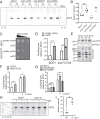Ribosomal RNA 2'- O-methylations regulate translation by impacting ribosome dynamics
- PMID: 35294285
- PMCID: PMC8944910
- DOI: 10.1073/pnas.2117334119
Ribosomal RNA 2'- O-methylations regulate translation by impacting ribosome dynamics
Abstract
SignificanceThe presence of RNA chemical modifications has long been known, but their precise molecular consequences remain unknown. 2'-O-methylation is an abundant modification that exists in RNA in all domains of life. Ribosomal RNA (rRNA) represents a functionally important RNA that is heavily modified by 2'-O-methylations. Although abundant at functionally important regions of the rRNA, the contribution of 2'-O-methylations to ribosome activities is unknown. By establishing a method to disturb rRNA 2'-O-methylation patterns, we show that rRNA 2'-O-methylations affect the function and fidelity of the ribosome and change the balance between different ribosome conformational states. Our work links 2'-O-methylation to ribosome dynamics and defines a set of critical rRNA 2'-O-methylations required for ribosome biogenesis and others that are dispensable.
Keywords: 2′-O-methylation; rRNA modification; ribosome biogenesis; ribosome dynamics; translation regulation.
Conflict of interest statement
The authors declare no competing interest.
Figures




References
-
- Ayadi L., Galvanin A., Pichot F., Marchand V., Motorin Y., RNA ribose methylation (2′-O-methylation): Occurrence, biosynthesis and biological functions. Biochim. Biophys. Acta. Gene Regul. Mech. 1862, 253–269 (2019). - PubMed
MeSH terms
Substances
Grants and funding
LinkOut - more resources
Full Text Sources

